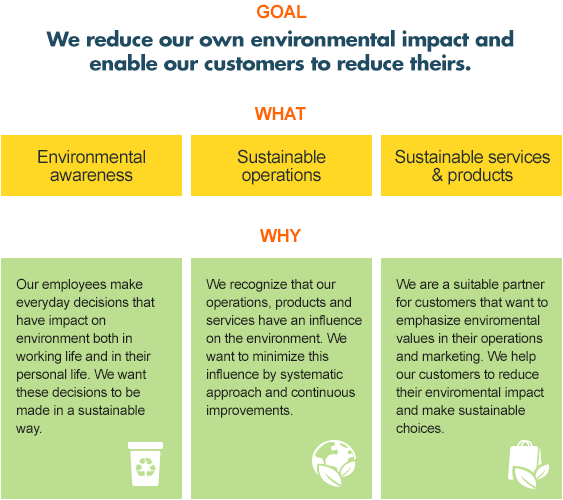Watch Mika Ruuskanen talking Edita's environmental responsibility
Achievements in 2012
Our most important achievements in 2012 were that three new offices – JG Communication’s in Stockholm and Citat’s in Stockholm and Helsinki – were awarded the WWF’s Green Office certificate, and that we significantly improved energy efficiency at our production plants in Helsinki and Västerås.
Our environmental strategy

Environmental targets for 2015
We will reduce our carbon footprint by 40 percent compared with 2008. This means that:
- all of our production plants and offices will use green electricity
- we will have a unified travel and car policy
- we will have a unified method for calculating emissions. Our calculations will include fuel, energy consumption, business travel and transport
- we will compensate for all emissions generated by business trips.
All of our companies will have a certified environmental program:
- all of our printing facilities will be ISO 14001 certified
- all of our offices will be WWF Green Office certified
- all of our production plants will have the right to use the Nordic Ecolabel
- all of our production plants will be FSC certified.
We increase environmental awareness among our employees, customers and suppliers of goods and services every year:
- we publish the results of our environmental work in our annual corporate responsibility report
- the themes and goals of our environmental work are kept up-to-date and available to everyone on our intranet
- we provide our customers with products that carry the Nordic Ecolabel and that are FSC certified
- more than 90 percent of our staff will consider it important for Edita to be a leading company in environmental matters
- we will have a unified method for working with suppliers of goods and services.

The following principles will be adhered to when procuring paper:
- we will scrutinize the environmental responsibility programs and wood procurement principles of paper suppliers
- we will prioritize paper that carries the Nordic Ecolabel and is CoC certified
- we will increase the amount of CoC-certified paper procured year on year (2 250 tons in 2012)
- we will prioritize paper that is manufactured in the Nordic countries.
Our goal for electricity procurement is that by 2013, all of Edita’s production and office sites will use electricity generated from renewable sources. Edita’s main production plants already use solely renewable energy: Edita Västra Aros uses hydroelectric power and wind power, Edita Prima hydroelectric power and wood-based biofuels.
Chemicals used in printing carry the Nordic Ecolabel. Before introducing a new chemical into the process, its right to carry the Nordic Ecolabel will always be checked with the organization that grants the right to use the label.
Products and services 2012
To reduce their environmental impact, companies must choose the right materials and production methods. We recommend the use of internationally recognized labels, as they send a visible message about environmental responsibility.
The Nordic Ecolabel
The environmental impact of printed products has been considered throughout the production chain, from paper manufacturing to the delivery of the finished product. The printed product fulfills the Nordic Ecolabel’s standards for forest management, pulp and paper manufacturing, printing and waste management.
Edita’s main production plants have been granted the right to use the Nordic Ecolabel. The Group’s net revenue from products carrying the Nordic Ecolabel was about EUR 2.1 million in 2012.
Guarantees of origin – paper
Forest certification ensures that forests are managed according to agreed criteria and that the wood fiber used is monitored from forest to finished product.
The forest management criteria apply to matters such as:
- compliance with national laws and international agreements
- respect for the rights of indigenous peoples and of workers
- maintaining the biodiversity of forests
- preserving forests with a significant environmental protection value.
The processes we engage in at Edita’s production plants to track down the source of paper are certified according to international reference standards. For this reason, our printing companies are entitled to use labels showing that our paper originates from a responsibly chosen source. The Group’s net revenue of printed products with Chain of Custody (CoC) labels was about EUR 1.7 million in 2012.
Ecological footprint
For several years, Edita has been surveying the environmental impact created by its printed products. This ecological footprint describes the environmental impact and carbon footprint of a printed product. We now have a software application with which we can calculate the carbon footprint of an individual printed product more accurately.
Supply chain
From the perspective of environmental responsibility, Edita’s most significant purchases are those related to the paper and electricity supply chains. Edita will not procure paper that originates from illegal felling or from forests with a significant environmental protection value.

One important step in reducing our carbon footprint has been the transition to electricity from renewable sources (green electricity) at all production sites.
Our long-term target is to reduce our carbon-dioxide emissions to 40 percent of the 2008 level by 2015.
As of 2012, the following Edita companies are climate-neutral: Edita Publishing, Edita Prima, Edita Västra Aros, Mods Graphic Studio and JG Communication. These companies have reduced their carbon emissions from operations and compensated for the remaining emissions by funding UN-supervised clean development mechanism projects in India.
Environmentally responsible operations
Offices
In office work, most of our environmental impact comes from energy consumption, paper usage and carbon-dioxide emissions caused by traveling. In 2010, Edita began investing in determined efforts to reduce the environmental impact of the Group companies’ offices.
In 2012, JG Communication’s office in Stockholm and Citat’s offices in Helsinki and Stockholm were granted Green Office certificates. As a result, Edita now has five Green Office-certified offices. In 2013, the Green Office system will be expanded into new companies.
The environmental systems for our production activities ensure that our environmental work is systematic and is focused on continual improvement. The systems also ensure that we follow current environmental legislation at Edita’s main production plants in Helsinki and Västerås, which are certified in accordance with the ISO 14001 standard for environmental management.
Printing houses
In our production activities, the main sources of environmental impact are materials, energy, waste, and emissions. We began measuring our waste volumes regularly in the 1990s. In 2012, around 92 percent of the total waste volume was recyclable. Over the past decade, the volume of waste that has been sorted separately has increased, but at the same time it has become possible to recycle a larger range of materials.
We have good cash flow from our waste disposal activities: the amount of waste sold brings in more funds than the amount paid for waste disposal.
In 2011, both Edita Prima and Edita Västra Aros made significant investments that improved their energy efficiency. The lighting systems at both of these production plants were replaced. Thanks to these investments, energy efficiency at both plants improved significantly in 2012.
At Edita’s production sites, energy is used to operate machines and equipment, as well as for heating, lighting and ventilation of the premises. All Edita companies use district heating, and their only water source is the municipal water supply.
Climate neutrality
Combating climate change is an important part of our corporate responsibility program. In autumn 2008, Edita began measuring the Group’s total carbon-dioxide emissions.

Environmental awareness
Our goal is to increase environmental awareness among our stakeholders. As a company in the communications sector, we have a particular responsibility for promoting environmental awareness.
We aim to ensure that Edita employees make decisions that comply with the principles of sustainable development both at work and at home.
In the staff survey carried out in spring 2012, employees were asked for their opinions on Edita’s environmental program. No fewer than 50 percent of respondents considered it very important that Edita serves as a model in environmental work, while 77 percent felt that it was either important or very important.
We help our customers find solutions that are as sustainable as possible. Edita’s websites www.ekojulkaisu.fi and www.miljoanpassadtrycksak.se feature information on how environmental issues should be considered in the various phases of designing and producing printed material.
Energy and water consumption at Edita's production sites
Electricity (MWh)
Heating (MWh)
Water (m3)
Consumption of materials at Edita's productions sites
Paper (tonnes)
Printing ink (tonnes)
Solvents (tonnes)
Trend in waste from Edita's procution sites
Recycled (tonnes)
Recovered (tonnes)
Hazardous waste (tonnes)
Waste at Edita's production sites 2012
CO2-emissions (CO2-tonnes)
CO2-emissions
(CO2 tonnes)
| 2007 | 2008 | 2009 | 2010 | 2011 | 2012 | |
|---|---|---|---|---|---|---|
| Edita Prima Oy | 3308 | 3308 | 1271 | 1220 | 918 | 805 |
| Edita Västra Aros Ab | 402 | 345 | 393 | 463 | 458 | 363 |
| Citat Ab | 152 | 152 | 152 | 101 | 149 | 216 |
| JG Communication Ab | 155 | 155 | 155 | 154 | 78 | 47 |
| Edita Publishing Oy | 121 | 121 | 121 | 114 | 90 | 89 |
| Edita Plc | 84 | 84 | 84 | 75 | 88 | 97 |
| Citat Oy | 35 | 35 | 35 | 35 | 35 | 34 |
| Mods Graphic Studio A | 13 | 13 | 13 | 12 | 13 | 10 |
| Total | 4271 | 4213 | 2223 | 2173 | 1830 | 1660 |
Corporate carbon Inventory
| Emission class | Source | 2007 | 2008 | 2009 | 2010 | 2011 | 2012 |
|---|---|---|---|---|---|---|---|
| Scope 1 Direct Greenhouse Gas emissions | |||||||
| EN 16 Direct and indirect Greenhouse Gas | Greenhouse Gas other climate impacts | 6.1 | 6.1 | 6.1 | 15.8 | 13.0 | 0.0 |
| EN 16 Direct and indirect Greenhouse Gas | Greenhouse Gas heating oil | 0.0 | 0.0 | 0.8 | 8.1 | 6.7 | 0.0 |
| EN 16 Direct and indirect Greenhouse Gas | Greenhouse Gas transport fuels, petrol | 100.4 | 96.8 | 86.3 | 80.7 | 52.0 | 43.8 |
| EN 16 Direct and indirect Greenhouse Gas | Greenhouse Gase transport fuels, diesel | 25.2 | 27.1 | 31.5 | 33.2 | 45.3 | 67.7 |
| Greenhouse Gas Protocol Scope 1, total | Direct Greenhouse total | 131.7 | 130.0 | 124.7 | 137.7 | 117.0 | 111.5 |
| Scope 2 Greenhouse Gas emissions from indirect energy | |||||||
| EN 16 Direct and indirect Greenhouse Gas | Greenhouse Gas other climate impacts | 9.6 | 9.6 | 38.2 | 53.5 | 2.6 | 7.5 |
| EN 16 Direct and indirect Greenhouse Gas | Greenhouse Gas purchased district cooling | 0.9 | 0.9 | 0.9 | 1.4 | 1.9 | 1.7 |
| EN 16 Direct and indirect Greenhouse Gas | Greenhouse Gas purchased district heating | 514.1 | 516.4 | 580.9 | 616.3 | 529.7 | 528.2 |
| EN 16 Direct and indirect Greenhouse Gas | Greenhouse Gas purchased eco-labelled electricity | 2.1 | 2.0 | 8.8 | 6.6 | 5.3 | 4.6 |
| EN 16 Direct and indirect Greenhouse Gas | Greenhouse Gas purchased electricity | 2036.0 | 2036.3 | 54.7 | 75.4 | 69.8 | 59.3 |
| Greenhouse Gas Protocol Scope 2, total | 2562.7 | 2565.2 | 683.5 | 753.2 | 609.3 | 601.2 | |
| EN 16 Direct and indirect Greenhouse Gas | 2694.4 | 2695.2 | 808.2 | 890.9 | 726.3 | 712.7 | |
| Scope 3 Other indirect Greenhouse Gas emissions | |||||||
| EN 17 Other indirect Greenhouse Gas | Business travel: flights | 345.6 | 344.6 | 247.5 | 207.8 | 206.3 | 235.9 |
| EN 17 Other indirect Greenhouse Gas | Business travel: others | 3.6 | 3.7 | 2.2 | 1.7 | 2.4 | 1.8 |
| EN 17 Other indirect Greenhouse Gas | Business travel: taxi, private car or rental car | 61.4 | 68.6 | 62.1 | 46.2 | 48.5 | 52.2 |
| EN 17 Other indirect Greenhouse Gas | Employee commuting | 757.3 | 755.3 | 640.8 | 609.5 | 561.0 | 430.8 |
| EN 17 Other indirect Greenhouse Gas | Transportations of finished products | 408.2 | 345.7 | 462.5 | 417.2 | 312.9 | 226.9 |
| Green House Gas -protokolla luokka 3, yhteensä | 1576.1 | 1517.9 | 1415.1 | 1282.5 | 1131.1 | 947.6 | |
| EN 17 Muut epäsuorat kasvihuonekaasupäästöt, yhteensä | 1576.1 | 1517.9 | 1415.1 | 1282.5 | 1131.1 | 947.6 | |
| Greenhouse Gas Protocol Scope 1, 2, 3, total | 4270.5 | 4213.1 | 2223.3 | 2173.3 | 1857.4 | 1660.3 | |
Edita has taken the following measures to reduce its carbon footprint
- All our production facilities use electricity produced using renewable energy sources.
- We have increased efficiency at our production and office facilities by merging sites.
- The Vilppula production plant was sold at the beginning of 2012.
- We have made investments to improve energy efficiency, such as replacing the lighting system in our production plants.
- We use video conferencing for the Group’s internal meetings, thereby reducing business travel.
- Workstations have been linked to a remote fire-extinguishing system.
- We have redefined the Group’s company car policy; we now use lease cars that are less harmful to the environment.
- Environmental issues have been added to the Group travel policy.
- Carbon-dioxide emissions have been compensated for by funding UN-supervised clean development mechanism projects.
- We use transport services in Finland that are environmentally compensated for.
- Employees have received training in environmental issues.

